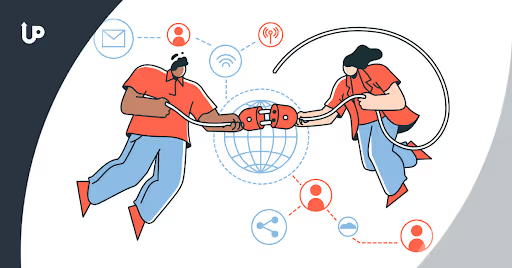Word-of-mouth marketing (WOMM) is like discovering a fantastic new restaurant or movie from a friend who’s tried it. Imagine your friend raving about how amazing their discovery was. You’re likely to trust their opinion and give it a shot, right?
Brands from around the world actively use word-of-mouth marketing to spread information and increase their organic growth. In this guide, we’ll reveal some word-of-mouth marketing examples by businesses people know and trust!
But first, let’s have a simple recap of word-of-mouth marketing — what it is and why it’s important. Keep on reading.
What Is Word of Mouth Marketing?
Word-of-mouth marketing is a form of promotion where satisfied customers share their positive experiences with a product, service, or brand with other people. It can happen both offline, through face-to-face conversations, and online, through social media, reviews, and other digital platforms.
An example of offline word of mouth is when someone mentions how satisfied they are with a product or service, and recommends it to you through a casual conversation in person.
For example, during a family gathering, you ask a family member for their experience with a milk brand. If it’s positive, you might feel inclined to give the brand a try, but when their review is negative, you might consider other brands instead.
Online, word-of-mouth marketing can happen when you are scrolling through your social media feed, and you come across a post from a friend. For instance, they shared a photo of a recently bought smartphone, talked about its features, and mentioned how it improved their daily life. Others in their network might see the post and be influenced by the recommendation.
Key takeaway? Whether offline or online, word-of-mouth marketing relies on personal experiences being shared. It can significantly impact the perception and choices of potential customers. 😀
The Importance of Word of Mouth Marketing
According to a global survey on Statista, consumers trust personal recommendations from people they know more than other advertising channels.
Moreover, an RRD survey in the US found that 55% of consumers learned about a new brand, product, or service through word of mouth, and 40% of consumers purchased a product after discovery.
These findings emphasize the trustworthiness of personal recommendations and the impact of word-of-mouth marketing on trust, brand discovery, and the purchasing behavior of consumers.
Let’s explore the reasons why you should explore word of mouth in your marketing strategy:
1. Credibility and trust
People trust the opinions of those they have personal relationships with because they believe that these recommendations are based on genuine experiences. Word-of-mouth is often rooted in real-life experiences and is also perceived as unbiased and impartial. That’s why it can help build credibility and trust for your brand! ♥️
2. Increased brand awareness
As satisfied customers share their experiences through positive word of mouth, their social circles become exposed to the information. This can create a ripple effect, reaching a wider audience beyond the initial sharer. Today, word of mouth can extend to social media platforms where recommendations are shared among a global audience.
3. Higher conversion rates
When potential customers receive positive recommendations from people they trust, they feel more confident in trying a product or service. This is because word of mouth helps reduce the perceived risk that usually comes with trying a new product or service.
Positive Word-of-Mouth Marketing Examples
Positive word-of-mouth marketing refers to the spread of favorable recommendations, comments, and feedback about a brand, product, or service. This leads to the question, “What are the best examples of word-of-mouth marketing?”
Here are real-life examples:
BLACKPINK x Starbucks collaboration
BLACKPINK is a South Korean girl group that has a massive global fanbase while Starbucks is a multinational coffeehouse chain known for its espresso-based drinks and Frappuccinos (blended beverages).
During the summer of 2023, BLACKPINK and Starbucks collaborated to release a limited-edition collection of drinkware and lifestyle merchandise and a BLACKPINK-themed Frappucino.

To build anticipation for the campaign, Starbucks released social teaser posts that got fans to talk about the upcoming collaboration.
In addition, the brand created a video where the BLACKPINK members tried the limited-edition drink and chose their favorite drinkware — which served as word-of-mouth marketing and was perceived as personal recommendations to fans! 🤩
Slack gained 16,000 users in 2 weeks
Slack is a messaging platform designed for team communication and collaboration. It is widely used by businesses and organizations, especially those working remotely or in different locations.
Slack utilized positive word-of-mouth marketing to attract new users. They compiled testimonials from different companies and collected tweets that expressed favor for the brand. By doing these, Slack relied on its users to become its brand advocates, which effectively boosted its reputation in the industry.
In-N-Out Burger
In-N-Out Burger is a well-known American fast-food restaurant chain known for its hamburgers, cheeseburgers, and hand-cut fries. The chain has a simple menu, only having three combo meals to choose from.
But what makes their restaurant special is the not-so-secret menu, which sparks curiosity among consumers. It consists of unofficial items that customers can order, such as “Protein Style,” which is a burger served with a lettuce wrap instead of a bun.
In-N-Our Burger’s not-so-secret menu creates a special experience for customers who are “in the know.” Secret menus can be powerful for word-of-mouth marketing because they also promote curiosity to those who haven’t tried the menu items.
Customers can post their unique orders online and share their experience with their family and friends!
Lesna and Their Influencer Partnership
Influencer marketing is a form of word-of-mouth marketing that involves leveraging influential individuals to promote a product or service.
Lesna, a Romania-based platform that does contests and giveaways for brands, used this strategy. They used UpViral to run an influencer giveaway for iSTYLE, an Apple reseller based in the same country, to increase email subscribers.
Lesna chose to work with Codin Maticiuc, an author, businessman, and producer in Romania. Codin has over 300K followers at that time, and he is also known for conducting giveaways.

Lesna featured Codin in their giveaway marketing materials. They promoted the giveaway on social media, and the 10-day UpViral campaign ended with a total of 12,677 leads!
🤓Learn more: Creating an Influencer Marketing Strategy for Your Giveaway Campaign
Van Maanen Holiday Homes
Eline van Maanen is the founder of Van Maanen Holiday Homes, a holiday resort for dog owners and their dogs. To increase brand awareness, she used UpViral to conduct an evergreen campaign. The prize was a free weekend stay for the winner and their dog/s at one of the luxury chalets.
Van Maanen Holiday Homes also benefited from this giveaway since the chosen winner would provide feedback or testimonials that could be posted on the Facebook page. This served as social proof, which encouraged more customers to choose Van Maanen Holiday Homes!
More Ways to Drive Word of Mouth Marketing
Driving word-of-mouth marketing involves strategies to motivate more people to talk positively about your product, service, or brand. Here’s how to increase word-of-mouth marketing:
Host events and experiences
Events can generate positive word-of-mouth marketing when they can provide memorable and shareable moments for attendees. These include photo opportunities, interactive displays, or other settings that can be captured and shared on social media. Here are some examples:
- Pop-up shops
- Launch events
- Concerts
- Workshops
- Food festivals
- Fashion shows
- Technology expos
Implement referral programs
Referral programs are designed to incentivize existing customers to refer new customers to a business, product, or service. It uses the power of word-of-mouth marketing and personal recommendations to acquire new customers.
Referral programs involve rewarding the referrer (an existing customer) and the referee (a new customer). Incentives can take various forms, such as discounts, free products or services, or exclusive access. These programs are effective because they tap into the trust existing customers have with their networks.
🔥Check out these case studies to learn how businesses use UpViral in their referral marketing strategy.
Encourage user-generated content (UGC)
User-generated content (UGC) is content that is created by users or consumers who have used a product or service of a brand. It is a powerful tool for word-of-mouth marketing because it provides relatable content that resonates with other consumers.
Examples of UGC content include social media posts, blog posts, YouTube videos, TikTok creations, and Instagram Stories. You can encourage this type of content by featuring them on your brand channels, incentivizing participation, and engaging with your community on social media and other platforms.
Final Thoughts
Positive word-of-mouth can influence potential customers, build trust, and reduce barriers to conversion. When you encourage word of mouth in your marketing strategy, you can experience higher conversion rates as a result.
There are many ways to do this, such as running giveaways, launching a referral program, working with influencers, encouraging user reviews and content, and hosting events!
Use these positive word-of-mouth examples as an inspiration for your brand’s marketing strategy. If you’re looking for a platform to create and run contests and giveaways, you can check out UpViral! See our features here or get started right away.

.avif)



.png)